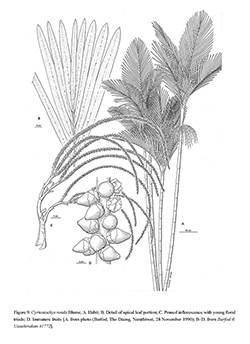e-Flora of Thailand
Volume 11 > Part 3 > Year 2013 > Page 396 > Arecaceae > Cyrtostachys
Cyrtostachys renda Blumewfo-0000936248
Bull. Sci. Phys. Nat. Néerl. 1: 66. 1838.— Bentinckia renda (Blume) Mart., Hist. Nat. Palm. 3: 316. 1853. Plate CII: D. Fig. 9.
Accepted Name : This is currently accepted.
Synonyms & Citations :
Description : Caespitose moderate-sized palm, usually with 3–5 adult stems per clump, each 5–10(–15) m high. Stem 6–10 cm diam., internodes 15–25 cm long. Leaves 7–10 in crown, crownshaft 0.8–1 m long, bright red; petiole 5–15(–30) cm long, red, channelled adaxially; rachis 1.5–1.8 m long, with 26–40 pinnae on each side, the middle ones 0.55–1.1 m long. Inflorescence 70–90 cm long, branched to 2(–3) orders, greenish turning dark purplish-red during fruit maturation, peduncle 5–8 cm long, rachis 15–25 cm long, rachillae 25–75 by 0.4–0.6 cm. Male flowers 0.2–0.25 cm long, asymmetrical, keeled, brownish; female flowers 0.4–0.5 cm long, keeled, reddish-brown to black. Fruit 0.7–1 cm long, ellipsoid to ovoid, light green turning black at maturity.
Thailand : PENINSULAR: Nakhon Si Thammarat, Phatthalung, Trang, Pattani, Narathiwat.
Distribution : Peninsular Malaysia, Sumatra (type), Singapore, Borneo.
Ecology : Naturally occurring only in freshwater peat swamp forests near sea level. In Peninsular Malaysia it is found up to 500 m alt. in upland peat swamps.
Vernacular : Mak daeng (หมากแดง)(Bangkok); kap daeng (กับแดง), ka daeng (กะแด็ง)(Nakhon Si Thammarat); mak wing (หมากวิง)(Pattani).
Uses: Ornamental.
Conservation Status: This species has become increasingly rare in Thailand due to collection of palms from the wild for cultivation.


